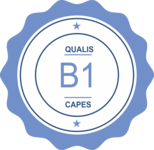Proposte
Vai al Login o Registrazione sono richiesti per sottoporre articoli.
Lista di controllo per la predisposizione di una proposta
Todas as submissões devem atender aos seguintes requisitos.
- A contribuição é original e inédita, e não está sendo avaliada para publicação por outra revista; caso contrário, deve-se justificar em “Comentários ao editor”.
- O arquivo da submissão está em formato Microsoft Word.
- Citações eletrônicas (textos da Internet e/ou mídias acessórias) utilizadas como referências bibliográficas deverão ser necessariamente citadas de acordo com as regras da ABNT e conforme especificado pelo periódico.
- O texto está em espaço 1,5; usa uma fonte de 12-pontos; emprega itálico em vez de sublinhado (exceto em endereços URL); as figuras e tabelas estão inseridas no texto com as devidas identificações de autoria, não no final do documento na forma de anexos.
- O texto segue os padrões de estilo e requisitos bibliográficos descritos em Diretrizes para Autores, na página Sobre a Revista.
- Em caso de submissão a uma seção com avaliação pelos pares (ex.: artigos), as instruções disponíveis em Assegurando a avaliação pelos pares cega foram seguidas.
Seção Especial
Diretrizes para Seção Especial
- A Seção Especial da Revista Fronteiras de Teologia do PPGTEO, como o próprio nome sugere, é uma sessão que se destina à publicação de Artigos, Ensaios ou Trabalhos de temas específicos.
- Sobre as chamadas e publicações, a sessão especial não será regida por uma regularidade ou periodicidade, ela será determinada pela Equipe Editorial considerando eventos ou personalidades relevantes ou de acordo com o perfil da Revista. A todos os temas serão dados enfoques teológicos correspondentes ao propósito da Revista.
- Uma vez que não há regularidade ou previsão de quando haverá sessões especiais, os autores serão convidados pela Equipe Editorial considerando a familiaridade com a temática a ser tratada.
- Excepcionalmente nesta seção, poderão publicar além do perfil de autores designado pelo escopo da revista em chamada regular, mestres, especialistas e/ou habilitados na temática especial. Os autores não necessariamente precisam estar vinculados a algum programa de graduação ou pós-graduação.
- Todas as demais regras serão seguidas de acordo com as diretrizes das chamadas regulares.
Tema Livre
Política padrão de seçãoResenha/Recensão
Editorial
Apresentação do tema do dossiê elaborado por pesquisador/a importante da área.
A apreciação dos textos é feita por membros da equipe editorial.
Informativa sui diritti
Autores que publicam nesta revista concordam com os seguintes termos:
- Autores mantém os direitos autorais e concedem à Fronteiras - Revista de Teologia da Unicap o direito de primeira publicação, com o trabalho simultaneamente licenciado sob a Licença Creative Commons Attribution que permite o compartilhamento do trabalho com reconhecimento da autoria e publicação inicial nesta Revista.
- Autores têm autorização para assumir contratos adicionais separadamente, para distribuição não-exclusiva da versão do trabalho publicada nesta revista (ex.: publicar em repositório institucional ou como capítulo de livro), desde que reconheça e indique a autoria e a publicação inicial nesta Revista.
- Autores têm permissão e são estimulados a publicar e distribuir seu trabalho online (ex.: em repositórios institucionais ou na sua página pessoal) a qualquer momento depois da conclusão de todo processo editorial, já que isso pode gerar alterações produtivas, bem como aumentar o impacto e a citação do trabalho publicado (Veja O Efeito do Acesso Livre).





















